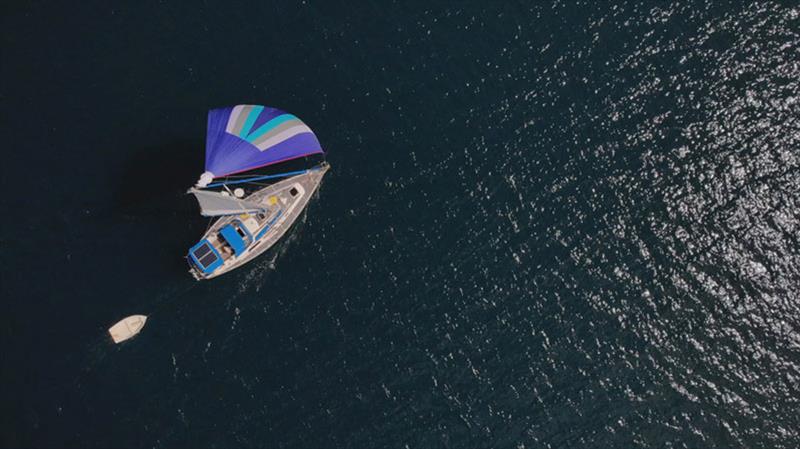How To Use A Spinnaker Sail

Beginners guide to using a Spinnaker!
past Sam Newton, Rolly Tasker Sails 21 Mar 2021 05:00 HKT
 Beginners guide to using a spinnaker © Rolly Tasker Sails
Beginners guide to using a spinnaker © Rolly Tasker Sails
A great video and interesting commodity courtesy of our friends at Rolly Tasker Sails, Commonwealth of australia
The Asymmetrical Spinnaker is one of the favourite sails in the cruising sailor's wardrobe.
A young couple cruising the world take produced a great video full of excellent tips on how to get the best out of your Asymmetrical Spinnaker in a relaxed and piece of cake manner, and without any of the hassle or stress that many fear.
Their video shows a clear, step-past-step guide on how best to hoist, trim and driblet your Asymmetrical Spinnaker.
Hoisting the Asymmetrical Spinnaker
For the hoist, these are the principal points.
The three corners of an Asymmetrical Spinnaker are marked as Tack, Head and Clew. You just attach the tackline to the Tack of the sail, the halyard to the Caput and the canvas to the Clew. You can then atomic number 82 your tackline through a block in front of and outside the pulpit, back to a cleat or jammer on the deck so that it can be adjusted. Sheets tin exist attached to the sail with either a bowline or with a snap shackle.
In one case the sheet is attached you lot can bear off to roughly 160 degrees off the wind, ease the principal out, and then hoist the Asymmetrical Spinnaker either by itself or in its spinnaker sock in the air current shadow of the mainsail.
Once the Asymmetrical Spinnaker is fully hoisted and the halyard cleated, yous should luff upward slightly then that the canvas can fill with current of air, or if y'all are using ane, every bit the sock is pulled upwardly.
Trim of the Asymmetrical Spinnaker
The video clearly shows the trim of the sheet - simply let out the canvas until the luff of the canvass merely begins to curl.
This is the all-time trim for racing and for concentrated hand-steering, even so, for the more relaxed cruising mode, running under autopilot or a cocky-steering system, y'all should canvas in a bit more to allow for any inaccuracies in steering.
The all-time wind-angles for a cruising Asymmetric Spinnaker are between 80 and 120 degrees off the apparent air current, that is, from but forward of the beam to a wide reach.
Using the Spinnaker Pole
If you want to run even further downwind then in that location is a skilful way of adapting your Asymmetrical Spinnaker for deep downwind sailing, once again as shown in the video.
When sailing downwind, the Asymmetrical Spinnaker tin can get blanketed by the mainsail.
To be able to pull the canvas clear out of the wind-shadow created by the mainsail, nosotros can utilise a spinnaker pole set quite low on the mast because an Asymmetrical Spinnaker is cut with a very low tack.
When the pole is set, you can run a new sheet, sometimes called a caryatid or guy, through the outboard terminate of the pole and to the tack line, where or it can be clipped on (this is demonstrated very well in the video).
Y'all can then trim the pole by pulling the sheet out to the 'windward' side. The iii lines - brace (likewise known every bit a guy), tackline and uphaul of the pole - can be used to fix the pole in a stable position.
To preclude the leech of the sail from swaying too much yous can attach what is known as a Tweaker, preferably with a snatch-block, to pull the sheet down and stabilise the sail. Again, this is clearly shown in the video.
Using a Tweaker is a straightforward process.
Dropping the Asymmetrical Spinnaker
Y'all just bear abroad until the sail is blanketed from the wind past the mainsail and so, allow out the sheet until there is no wind at all left in the asymmetrical spinnaker. Finally, if you are using a spinnaker sock, pull down the sock over the sail.
If pulling the downhaul line of the sock downwardly when standing on deck, it is actually not very secure. Information technology is better to lead the downhaul line through a ratchet-block on deck and pulling the line from the block upwards is much easier.
You tin can even do this while sitting down on deck which is much safer if a sea is running. Finally, the ratchet block will help you to safely agree on to the downhaul even if a gust of wind should try and pull you off the deck!
Bask!
We hope that y'all will enjoy this video, just even more, that you will feel confident to use your Asymmetrical Spinnaker to take full advantage of your boat's performance and take much more fun.
If you wish to follow Matt and Amy's voyages, have a await to their Youtube aqueduct.
For more information on the spinnaker and spinnaker sock used in this video be certain to visit the Rolly Tasker Sails website or contact the team at Rolly Tasker Sails:
Rolly Tasker Sails - Commonwealth of australia
Greg - 0413 705559 or Sam - 0450 636190
How To Use A Spinnaker Sail,
Source: https://www.sail-world.com/news/236121/Beginners-guide-to-using-a-Spinnaker
Posted by: hansonlins1970.blogspot.com


0 Response to "How To Use A Spinnaker Sail"
Post a Comment